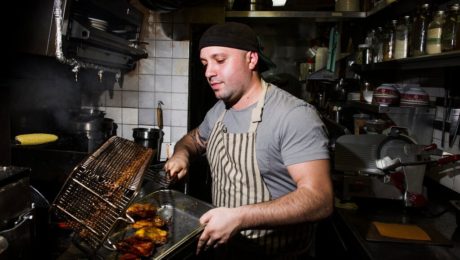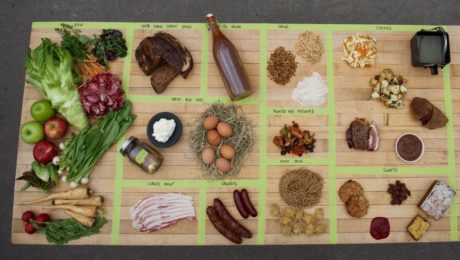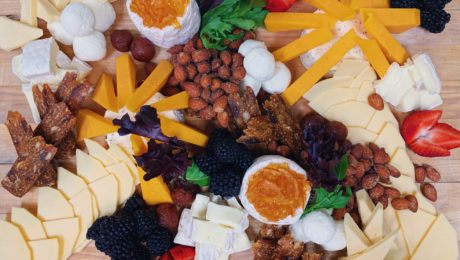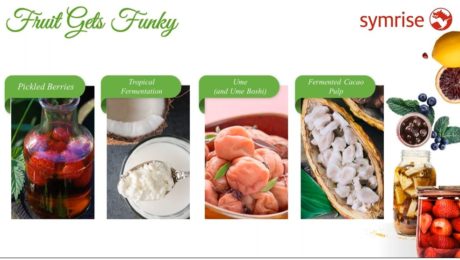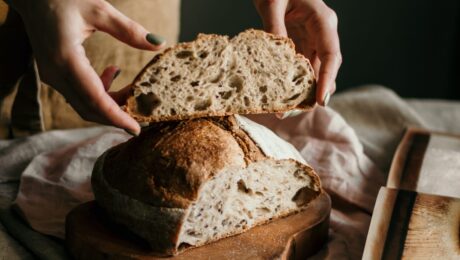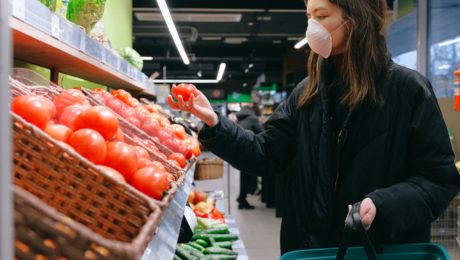Charcuterie Without the Meat
Charcuterie is getting a new, vegan look — “all of the smoke but none of the meat,” declares the New York Times. Chefs are experimenting with veggies and fruit, curing, smoking and serving them on a charcuterie. “We use the same ancient techniques of meat charcuterie — salting, curing, drying, fermenting and smoking,” says Will Horowitz @willhorowitz chef and co-owner of Ducks Eatery @duckseatery in Manhattan: “The trick is finding the right cocktail for each vegetable.”
Think Watermelon ham, radish prosciutto, burdock root jerky sticks, smoked carrot hot dots, smoked shiitake mushrooms, deviled kohlrabi and fire-charred Chioggia beets.
“Vegetable charcuterie is complicated,” adds Jeremy Umansky @tmgastronaut chef at Larder @larderdb in Cleveland and co-author of the book “Koji Alchemy: Rediscovering the Magic of Mold-Based Fermentation.” “To get the cure to penetrate the vegetable, first you have to soften it by smoking. But soften the cell structure too much, and the vegetable collapses. Smoke it too hot or too long, and you close the pores and dry it out. The texture definitely affects the flavor.”
Read more (New York Times)
- Published in Food & Flavor
Fermentation Helps Blue Hill Support Farmers
In an effort to help struggling farms during the coronavirus pandemic, Blue Hill at Stone Barns is expanding their fermentation program.
The upscale restaurants (Blue Hill in Manhattan and Blue Hill at Stone Barns in Westchester County) have long been at the forefront of farm-to-table dining. But, like all restaurants in New York, Blue Hill closed in March when the coronavirus pandemic broke out. Though co-owners Dan and David Barber are confident the traditional restaurant model will once again return, the brothers are troubled by the catastrophic impact on farms.
Blue Hill Farm and Stone Barns Center (a non-profit farm and educational center) have partnered to form a new entity resourcED, which surveyed over 500 farmers. A key conclusion — over a third of farms will not survive the pandemic. August sales at farms are expected to be down by 50% due to the COVID-19 pandemic, and over 30% of farmers say they are struggling to cover expenses.
“The excess product is a huge concern. That’s shaped our box program, our fermentation program,” says Andrew Luzmore, Blue Hill’s market forager.
The resourcED survey was the impetus at Blue Hill to launch their picnic dining and box program. Diners can buy a picnic dinner and eat a farm-to-table meal on the farm’s patio or lawn (physically distanced from others), still allowing Blue Hill to purchase food from local farmers. This program allows consumers to pick-up a box full of produce, dairy products, seafood or meat, all sourced from local farms.
Blue Hill’s mainstay fermentation and preservation programs, used for over 15 years to maintain food flavor and nutrients through long Northeastern winters, have also been expanded, to absorb more of excess farm production.
“The focus on preservation program is bred out of necessity, and necessity breeds creativity,” says Cortney Burns, chef, fermentation consultant for Blue Hill and author of “Bar Tartine, Techniques & Recipes” and the forthcoming “Nourish Me Home.” “What we’re doing now with fermentation at Blue Hill rides on the coattails of what has been part of the backbone of Blue Hill for years. Working here has me looking at fermentation through a different lens these days. How can we be completely in service to good agriculture? How can we create a greater economy for farms?”
Adds Luzmore: “The fermentation program has definitely expanded a lot. We’re shifting more to helping farmers with excess product.”
For example, Blue Hill recently purchased napa cabbage that would have been wasted from a Hudson Valley farmer. They are fermenting the cabbage, “making a delicious, nutritious probiotic-rich food for our diners, whilst buying up overabundant harvests,” Burns notes.
It’s conscious cooking, Burns says “We’re not just buying for the sake of preservation. We want to create variety.” Another example is how the Stone Barns Center is trialing preserving different beet varieties.
Fermented grapes and capers, buckwheat vinaigrette, peach umeboshi and whey tonic are among the creations Blue Hill has served picnic-style and in boxes. Some of the fermented food being offered is purchased from local farmers. Local cultured dairy — such as farm fresh cheese and yogurt — makes up a large percentage of their dairy box, for example.
“There are all these different ways we’re harnessing the power of fermentation,” Burns says. “We’ve had to shift our expectation of a restaurant kitchen. We need to make sure that first, the food doesn’t spoil, and second, that we have lots of probiotic rich food loaded with flavor to serve people.”
A picnic meal at Blue Hill is $195 per person and the boxes range from $45 to $170. Blue Hill is also donating boxes to families with food insecurities.
Luzmore hopes other restaurants will innovate ways they can support local farms during the pandemic. “It’s almost impossible to buy exactly the amount a restaurant needs, especially now when there’s a greater need to support farms. Considering the constant and changing flux of product coming into the restaurant for the boxes and donations, fermentation allows for a more holistic approach of using excess product.”
“Chef Dan [Barber] has said many times throughout the launch of resourcED: we’ve kind of gone from being a restaurant to a food processing facility. Blue Hill is a fine dining restaurant. We still maintain that mentality and quality, but it’s at a different level. The scale, we’re now thinking of purchasing pallets instead of pounds.”
- Published in Business
“Backslop Romance” — Inoculation, Not Contamination
By: Marina Jade Phillips, Trellis & Co.
The first two months of 2018 marked both my first trip to Mexico and my first bicycle tour. Living on two wheels did not slow my fermentation habit; I toted stainless steel jars of fermented vegetables in my panniers. I credit consuming lacto-bacteria with my lack of stomach troubles that can plague travelers in South America. Regularly introducing healthy bacteria into our digestive tract is a great way of inoculating our body with microbes that are on our team. The amount of attention probiotics have received in recent years is long overdue. Traditional cultures have known about the delicious and health-promoting qualities of fermented foods for hundreds of years, even before it was scientifically proven.
Backslop is Such Beautiful Word
Contamination and inoculation are two sides of the same food processing coin: the impact of a small quantity of the right or wrong material can be drastic. The former is the stuff of nightmares for food companies forced to recall tainted products, and suffering travelers perched atop or hunched over a toilet. The latter is how fermented flavors have been passed down through time, sometimes across generations, from one bottle, crock, or barrel to the next. Inoculation is so ubiquitous to the craft that traditional sausage makers gave it a name: backslop.
Backslop, unsavory as it may sound, simply refers to the practice of saving a bit of the last successful batch and incorporating it into the new one, ensuring a small number of the micro-organisms that populated the previous batch will go forth and multiply. There are several reasons why this technique is valuable to both professionals and home cooks. Foremost, the time required for complete fermentation decreases dramatically. A new jar of sliced cabbage or jug of fresh squeezed fruit juice is teeming with all kinds of bacteria and yeast, some of which will produce the desired results, and some of which will produce something inedible.
By introducing a healthy colony early in the process, desirable microbes get a head start and usually out compete less desirable ones in the race to inhabit a new environment. If those microbes have a particularly unique characteristic (champagne yeast produces more carbon dioxide than other wine yeasts, for instance), that character can be reproduced, sometimes leading to outstanding strains by which certain makers and regions become famous.
A 5-Year Love Affair
In more humble corners of the globe, far from French vineyards, I once had a relationship with a sourdough starter that lasted five years.
A sourdough culture becomes more complex with age, and as time went by she (yes, she—around her first birthday I named her Henrietta) developed her own unique flavor. One morning, I came into my kitchen and saw Henrietta’s container on the floor, licked almost all the way clean. A dog had gotten up on the counter, somehow removed the lid, and all but devoured my precious bread making ally. I scraped the dried crust of starter that remained from the edges of the bowl and rehydrated it with water.
Over the next few days I added a bit more flour and water at regular intervals, and in less than a week my robust friend was back in action. I could have sighed, cursed dogs under my breath, and made a new starter, but I was attached to Henrietta, and thrilled to revive her with such little material.
The beginning fermenter has a few options for ensuring success. Of course, there is always the option of simply hoping for the best. Usually, if the food to be fermented is fresh and healthy and the containers and hands in contact with it are clean, odds are in our favor that the microbes that make things sour and bubbly are going to win. However, a splash of the liquid floating around the top of high-quality yogurt (look for something with “active cultures”) will introduce a bit of the right bacteria and speed the process along. A small slosh of juice from a thoroughly fermented sauerkraut or brined vegetable jar will help get the next one going.
Those interested in experimenting with fermented dough will be delighted to know that a sourdough starter is incredibly easy to make: stir equal parts flour and water every day until it smells sour. Wild yeast lands on top of the mixture and is incorporated with every stirring.
Aid this process by dropping an unwashed and unsprayed berry (grapes work best) into the mixture for a couple of days (retrieve the berry before it starts breaking down). Yeast which covers the skins of all fruits will slough off and populate the latent starter. To keep this culture thriving, the sourdough baker saves a small amount of the starter and adds to it more flour and water. Starters exist that are rumored to be hundreds of years old, passed down in just this way.
Practice Safe Fermenting
Interestingly, foods that are not fermented are more prone to contamination from bacteria that can make us very ill, and in the worst cases, kill us. The culprits in large and small-scale food poisonings are often raw and unfermented vegetables. By fostering beneficial bacteria in a salty and acidic environment, we can safely enjoy raw vegetables with all their fiber and nutrient content without the risk of ingesting pathogens.
About Trellis & Co.: We started as a family business created by a bioengineer living on a homestead in one of the remotest areas in the Lower 48. When “running to the store” is a 4-hour drive, every purchase must be a robust and functional investment. Here at Trellis + Co. we design products worth investing in.
Our lifestyle inspired our line of garden-to-table kitchen tools. As gardeners, cooks, and canners, we develop creative solutions to our own kitchen conundrums and pass on that wisdom to you. Also, since we’re kind of obsessed with the planet, our products are designed to last a lifetime — keeping money in your pocket and garbage out of landfills.
- Published in Food & Flavor
Scientists Discover Which Bacteria Transfer to Gut
Scientists in Italy have discovered lactic acid bacteria in fermented food transfers to the gut microbiome. Though this is a widely accepted health benefit of fermented foods, there is little scientific research linking fermented food and the microbiome. The study looked at distribution of lactic acid bacteria (LAB) in humans based on location, age and lifestyle.
LAB genomes were reconstructed from about 300 foods and nearly 10,000 human fecal samples from humans from different continents.
The most frequent LAB food in the human feces: streptococcus thermophilus and lactococcus lactis, commonly found in yogurt and cheese.
“Our large-scale genome-wide analysis demonstrates that closely related LAB strains occur in both food and gut environments and provides unprecedented evidence that fermented foods can be indeed regarded as a possible source of LAB for the gut microbiome.”
Read more (Nature Communications)
6 Ways Fermentation Brands & Restaurants Adapt
The current global health and economic situation is a far cry from business as usual. “Pivot” will be the new buzzword in the food and beverage industry, as fermentation brands and food service institutions must implement creative manufacturing and marketing solutions to maintain sales during the coronavirus pandemic.
“We are in a real-time focus group situation. …We’ve seen an acceleration of trends,” says Emmanuel LaRoche, vice president of marketing and consumer insights for Symrise, an international producer of flavors and fragrances. “This current situation will lead to new, large structural trends that are going to impact the next 15 years.”
Solving economic challenges posed by the coronavirus outbreak will be the “new normal” in the food and beverage industry. Here are six ways to adapt.
- Create More Online Instruction
As a brand, are you helping your consumer cook with your product? And what about the products you don’t sell. Canned goods and frozen foods are flying off grocery store shelves. Can consumers pair your product to create a meal with the pack of canned beans they panic bought or the pound of frozen berries?
“Consumers may be stockpiling shelf stable products, but it doesn’t mean that they know how to use them,” says Melanie Bartelme, global food analyst at Mintel. “Brands have an opportunity to help consumers who suddenly find themselves surrounded by dried foods and frozen foods. Direction and support, in the way of webinars, YouTube videos or Pinterest links, will help them feel confident cooking meals with these staples.”
2. Position Your Product into Consumer’s Home Routines
Though some states are lifting stay-at-home orders, allowing businesses to reopen, social distancing will alter regular business through 2020 – and likely beyond. Many people view dining in a restaurant, working in an office and exercising in a gym as too risky. Consumers are now eating, working and exercising at home. They’re also spending more time on self-care routines and home cleaning. How can businesses join the home-based routine?
“The formation of routine, it’s an action that typically takes 60 days to form. If we repeat something on a daily basis, we turn it into this new habit,” Laroche says. “So the question here is how quickly, if ever, will consumer behavior return to pre pandemic levels or are we at the beginning at a shift of how we spend our time?”
It’s unknown whether the affects likely becoming permanent. But brands should adapt to home living. Product delivery and e-commerce sales are essential to fermented food and beverage brands. But brands should also think outside the box. Marketing must pivot from “on the go” to “staying at home.” More than ever, consumers want their products to be convenient.
“The new normal at home may create many opportunities for companies and brands to provide a new and exciting product connected directly to what consumers are experience,” says Dylan Thompson, marketing and consumer insights manager with Symrise.
3. Create Business Opportunities for Consumer’s Shift in Spending
Many of the new consumer spending trends mirror what happened during the 2008 recession. During the Great Recession, consumers shifted their spending habits in the food and beverage industry. Consumers:
- Valued cost more than convenience.
- Switched from mainstream to value brands. There was a big increase in private label purchases especially, as consumers searched for better deals. Premium and top brands were more insulated as consumers sought affordable luxuries.
- Bought smaller, lower-priced food and beverage packages. Manufacturers switched to smaller packages as they downsized to improve margins.
- Shifted to purchasing at value channels, like big club stores (Costco, Sam’s Club).
- Stopping shopping frequently at gas station stores, correlating with dropping gas prices.
- Declined eating at restaurants, increasing eating at home.
Already, new shopping trends are emerging during the COVID-19 outbreak. These include:
- Decreasing brand loyalty. Consumers buy whatever brand is available when their favorites are out of stock.
- Revival of the center store. As consumers stock up and try to keep their pantry full of shelf-stable items, they’re shopping in the center of the store again.
- Stock up behavior. Sales at mass and club stores are increasing while sales at restaurants are decreasing.
- Increased sale of comfort items. Consumers are indulging in purchasing things they can enjoy from home.
- Greater shift to ecommerce. Online shopping and “click and collect” pick-up have become a popular option during the pandemic, especially in urban areas.
“There are opportunities for retailers to fill the void of what consumers are missing out on,” adds Thompson.
4. Restaurants Must Create a New Business Model
Restaurants have been dramatically hurt by the pandemic, especially non-chain restaurants. Estimates by Technomic show that, at the end of the pandemic, restaurants sales will decrease by 14-29%.
For comparison, at the end of the Great Recession from 2008-2009, restaurant sales only failed by 1.2%.
“We know that social distancing will have a long-lasting impact on food service,” Laroche says. “Social distancing has been particularly disastrous for on-premise beverage, alcohol sales as the dining, drinking side of the business has essentially disappeared.”
At the end of the pandemic, Technomic estimates 15% of restaurants will not reopen.
Restaurants must reformat their business model to allow takeout, curbside pickup, no contact delivery, cashless pickups and alcohol to-go. Some restaurants are even offering DIY kits, selling materials to recreate favorite restaurant dishes at home. Others have decreased dining space to expand the kitchen.
5. Capitalize on what People are Already Buying.
Shopping trends are falling into two categories: survival and sanity. There’s been explosive growth in the food and beverage category during the pandemic (74%), especially for alcoholic beverages (24%), according to IRI. Fermented products like foods like coffee (60.6%), spirits/liquor (37.3%), beer ale/cider (37.8%), chocolate (21.2%) are all top purchases. There are bigger trending categories where a fermented food or drink could get creative, like pasta (229.8%), soup (212.7%), salty snacks (51.5%) and cookies (50.3%).
Increased “beer and liquor at home is one of those sanity categories, and it’s always been well-known that it’s recession proof,” Thompson says. Alcohol flies off shelves during recessions. Consumers are looking for comfort and want a way to cope with uncertainty.”
Alcoholic drinks like hard seltzers and craft brew were not popular enough to track in 2008, but in 2020, are not proving to be a permanent part of consumer alcoholic beverage purchases.
6. Consider Consumer’s Storage Space
Storage at home has become a premium, especially for consumers in densely populated areas that have been hit the hardest by the pandemic. Think of younger, Millennial and Generation Z shoppers living in urban areas with limited storage space.
“The Propensity to stockpile food is a challenge to those without a place to store such products. There is an opportunity for condensed, dried foods, like bone broth soup and contemporary bouillon cubes, to be positioned as more viable alternatives,” says Dasha Short, a global food analyst with Mintel.
Fermented food and drink brands should consider selling items in single-service packages and snack sizes.
- Published in Business
Fermented Fruit Will Go Mainstream in 2020
Fermentation was the No. 2 trend on the North America Flavor Trend Report for 2020, but with a twist: sweet foods are the new star of fermentation. The trend report was released by Symrise, an international producer of flavors and fragrances.
“Over the past few years, we’ve seen fermentation has really come to dominate the condiment category with foods like kimchi, that have really led the charge,” says Julia Gorman, Symrise digital marketing specialist. Now, “fruit is getting funky.”
Pickling berries, fermenting tropical fruits, using sour fruits and incorporating pulp byproduct into fermented dishes are some of the key flavor trends among chefs. Adds Dylan Thompson, Symrise marketing and consumer insights manager: “It’s all about the evolution of fermentation.”
Fermentation was particularly high on the list because of gut health components. Fermentation encompasses some of the mega trends Symrise is seeing this year. Consumers are buying simple foods that benefit a healthy lifestyle. Fermentation’s “health benefits remain a huge bonus,” Gorman says.
Symrise polled chefs and mixologists for their survey, and found four fermented fruit flavor trends:
- Pickled Berries. Made popular through the cookbook “Noma’s Guide to Fermentation,” Scandinavian cuisine is making a major impact on America’s acceptance of fermented fruit.
- Tropical Fermentation. Mixologists have been particularly experimenting with tropical fruits in drinks. Fermented pineapple, for example, is used to “add flavor funk to what is otherwise a classic beach cocktail,” Gorman adds.
- Ume (and Ume Boshi). More chefs are using Ume, the salty, sour Japanese plum. It can be pickled, brined or traditionally served with rice.
- Fermented Cacao Pulp. Usually a wasted byproduct of cacao bean production, the pulp has an array of health benefits. Chefs are salvaging the pulp to use in a variety of dishes.
- Published in Business
The Science of Yeast, the Microbe in your Pandemic Bread
Humans have been baking fermented breads for at least 10,000 years, but commercial yeast and flour companies have never seen demand so high. National Geographic shares “a story for quarantined times, about extremely tiny organisms that do some of their best work by burping into uncooked dough.”
Scientists describe the microbes behind the work fermenting the bread. “It’s this wonderful living thing you’re working with,” says Anne Madden, a North Carolina State University adjunct biologist who studies microbes. She and partner scientists showed recently that when bakers in different locales use exactly the same ingredients for both starter and bread, their loaves come out smelling and tasting different. “Which I think is fantastic,” she says. “It’s evidence of the unseen. And as a microbiologist, you so rarely get to measure things about microbes with your nose and your taste buds.”
Read more (National Geographic)
- Published in Science
Functional Foods Grew 5.3% in 2019
Sales of functional foods and beverages — products that provide additional nutrients — grew 5.3% to $71.4 billion in sales in 2019, at a growth rate two times faster than conventional products. Sales of function foods and beverages were $68 billion in 2018. (New Hope Network)
- Published in Business
Fermenting Wild Food
Master forager Pascal Baudar shares insight from research for his new book, “Wildcrafted Fermentation: Exploring, Transforming, and Preserving the Wild Flavors of Your Local Terroir.” He believes more people should live off the land. He tells Modern Farmer: “Lacto fermentation really started to create a new level of dealing with wild plants and understanding how to get those wild plants from a culinary perspective.”
Read more (Modern Farmer)
- Published in Food & Flavor
Fermentation Booms During Pandemic
In a matter of days, the novel coronavirus outbreak dramatically changed grocery shopping. Empty grocery store shelves have become a ubiquitous symbol globally of home quarantine.
Sales exploded for pantry staples like dried beans (62.9%), powdered milk (126.3%) and rice (57.5%). But another grocery quarantine must-have item is emerging – fermented food and drink. Sales are up for kombucha (10.1%), natto is selling out in Japan, yogurt is selling out in Europe and pickle and sauerkraut sales in Russia are up 79%. Fermentation brands are reporting some of their biggest sales during the month of March, as much of the nation was forced into self-isolation to prevent the spread of COVID-19.
“For fermented food, it’s an interesting time. We’re an immune boosting type of food, so our sales are skyrocketing. We’ve had the best month we’ve ever had in business,” says Drew Anderson, CEO of Cleveland Kitchen and TFA board member. Cleveland Kitchen makes sauerkraut and fermented dressings and marinades. “It is bittersweet. Obviously, we want this virus to go away. But we’re seeing the fermentation industry as a whole, the one benefit is it’s driving a lot of trial. People say ‘I heard fermented food is supposed to be good for you, I’m cooking more, why not grab a pack of kraut.’”
Though sales are high, brands are changing their operation model. Rather than running two shifts of processing at Cleveland Kitchen, they’re down to one. Employees must take daily temperature readings before work, stop for mandatory handwashing breaks and use new Purell hand sanitizing stations.
“Sales are up overall, but we have had to implement our emergency sanitation protocols to continue production,” says Meg Chamberlain, CEO of Fermenti, LLC. The North Carolina-based brand sells a variety of vegetable ferments, teaches fermenting workshops and hosts annual the annual WNC Fermenting Festival. Their staff is under voluntary home quarantine – which means staff only goes from work to home. “Overall our company is proving resilient and we are hopeful to continue to provide Fermenti to our community.”
Because food production is considered essential business, licensed fermentation companies have not been forced to stop working during the coronavirus outbreak.
Aneta Lundquist, CEO of 221 B.C. Kombucha, has been posting videos to her Instagram stories of the Florida based kombucha processing facility. Lundquist says employees are working overtime to deliver orders.
“Our orders during the global pandemic have spiked. Consumers have gone full blown ‘healthy’ food during this health crisis,” she says. “Now is the time to make a switch from over-processed and denaturalized pseudo foods to real, natural and unprocessed foods that nourish our body, mind and spirit and help building a strong immunity.”
Lundquist adds customers need to “think of kombucha, kimchi, sauerkraut and other fermented fruits and vegetables as microbiome rock stars!…Always choose wildly fermented foods.”
“Remember it is about diversity and the quality of microorganisms, not just quantity. You can only achieve this by fermenting traditionally.”
Keenan Smith, CEO of Goodwolf Kefir in Portland, agrees. He says: “The probiotic and fermented space will increase as people have an increase in health awareness and want a better functioning immune system.” They are home delivering their kefir, and donating a
Brands are getting creative with their marketing, too. Goodwolf Kefir is home delivering kefir to the Portland area and donating a proceed of sales to their local food bank. Cultured South and Golda Kombucha have setup a pick-up fridge at their Atlanta location where customers can prepay for an order online, get a secret code to unlock the fridge and grab fermented food and drinks. Wild Kombucha in Baltimore is offering free, local, “no human touch” home delivery for their 12 pack bottles. 28 Mile Vodka & Distillery in Illinois have converted their distillery to make hand sanitizer that they call “Fool’s Gin.” The CEOs of Miyoko’s Creamery and Lifeway Kefir are both using the brands Instagram accounts to share recipes using their product.
Outside the U.S., though, different government rules are restricting fermentation brands from operating during the global outbreak. In India, Mountain Bee Kombucha has halted operations during a 21-day lockdown.
“There is no question that our business is impacted immensely, one for the fact that we are still quite small-scale which supplies directly to a handful of local grocery stores. Currently those grocery stores have been working at limited capacity and/or temporarily shut,” said founder and head brewer Honey Islam. “Another reason for lesser business in these times is due to the lack of awareness in the Indian market about fermented foods, especially kombucha. We are engaged in educating our customers as well as spreading awareness in the community via workshops, classes, 101 sessions, pop-ups, all these channels are education are currently disrupted which stalled our efforts in bringing kombucha awareness to the masses.”
Mountain Bee Kombucha is focusing on educating through Instagram videos and YouTube tutorials.
- Published in Business

